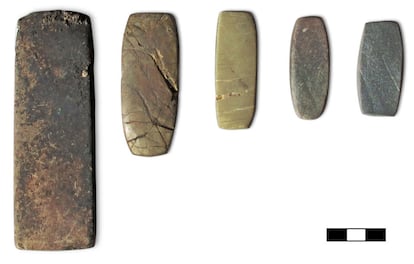Long before cryptocurrencies, mobile payments and investments in the stock market, the economy of an area was based on exchanging a surplus good for another that was needed.
Until the advent of coins and bills, bartering was the only known form of trade.
A new study suggests that the germ of what we now know as the European economic system appeared at the end of the Bronze Age, thanks to the popularization of a measurement system and countless bronze fragments that functioned as currency.
More information
An investigation dives to the Neolithic to find the origins of inequality between men and women
The study, published in the
Journal of Archaeological Science
, details that measurement tools began to be used in southern Italy between 2300 and 1700 BC.
These tools quickly spread throughout Europe and between 1200 and 800 BC they were already in use throughout the continent.
Giancarlo Lago and Nicola Lalongo, the authors of the study, describe these utensils as follows: “The only weighing device known at that time was the balance: a simple horizontal beam of wood or bone, with a central support point and two saucers. hanging on each side ”.
Different researchers have found numerous bronze and metal deposits from this time throughout Europe, the meaning of which has not been unraveled. The locations of these clusters are distributed indistinctly in numerous environments. Nor do they follow a religious or ritual pattern, since, despite finding fragments of swords or axes, all the parts of the same object are never found. The analysis of more than 3,000 pieces from 150 deposits found in Italy and northeastern Germany revealed that these follow a very close proportion to the stone weights used in the balances. "The weight of the fragments is always a multiple of the same unit of measurement," the researchers acknowledge. The weights vary between 8 and 10 grams, as does the
shekel
, the unit of measurement used in Mesopotamia and that always had an equivalent in silver.
The weights vary between 8 and 10 grams, like the shekel, the unit of measurement used in Mesopotamia and which always had an equivalent in silver.
The professor of Prehistory at the Autonomous University of Barcelona (UAB), Roberto Risch, points to an increase in the extraction and production of bronze: “The amount of metals that we find from 1300 BC is exponentially higher than that found in the Antique Bronze. That means a lot of metal is being produced and there is a lot of metal in circulation. " According to the researchers, this increase in the supply of bronze is explained by the fact that this material fulfills a double function: as a bargaining chip and as a raw material for making tools. Already in Mesopotamia, silver also fulfilled these same functions.
In addition, this material is distributed throughout the continent, even in areas where there were no mines of this type, such as the Scandinavian countries and the Mediterranean. Risch wonders how such quantities of that material could get within 800 kilometers of where it was extracted and answers his own question: "By exchange." The same expert explains that the intrinsic value of bronze comes from the laboriousness of its elaboration (extraction, reduction and smelting of the mineral, forging the metal, etc.). That, added to its small size that makes it easy to transport and the possibility of being able to melt it to make a new piece, places bronze as the perfect material to function as a coin. It is the same logic that we follow today. "It is much more common to pay with small bills of 5 or 10 euros than with one of 100 or 500", summarize Lalongo and Lago.
2000 BC weights
C. found in southern ItalyN.
Ialongo / others
"We always think that the origin of the currency had to be gold," says the professor from the Autonomous University of Barcelona, "but it is the least appropriate material because it is too limited in nature."
The only mineral abundant enough to establish itself as a bargaining chip was silver, although most of it was found in the Middle East.
Europe, for its part, was rich in copper mines.
Risch does not rule out that at some point other material was used, although he believes that it is impossible to know today: "There could be another type of currency, such as fabrics or grain, but archaeologically we are not able to recognize it as such."
“This study gives very solid evidence that, in addition to currencies, there is a measurable exchange system.
For the modern man it is something obvious, but for the formation of the currency and the markets it is not so obvious ”, considers Risch.
Researchers believe that the existence of money in Prehistory may represent a full stop in our concept of the modern world.
"If we admit that Western civilizations were not responsible for the invention of money, perhaps we can begin to banish the prejudices that support our supposed superiority," they say.
You can follow
MATERIA
on
,
and
, or sign up here to receive
our weekly newsletter
.

